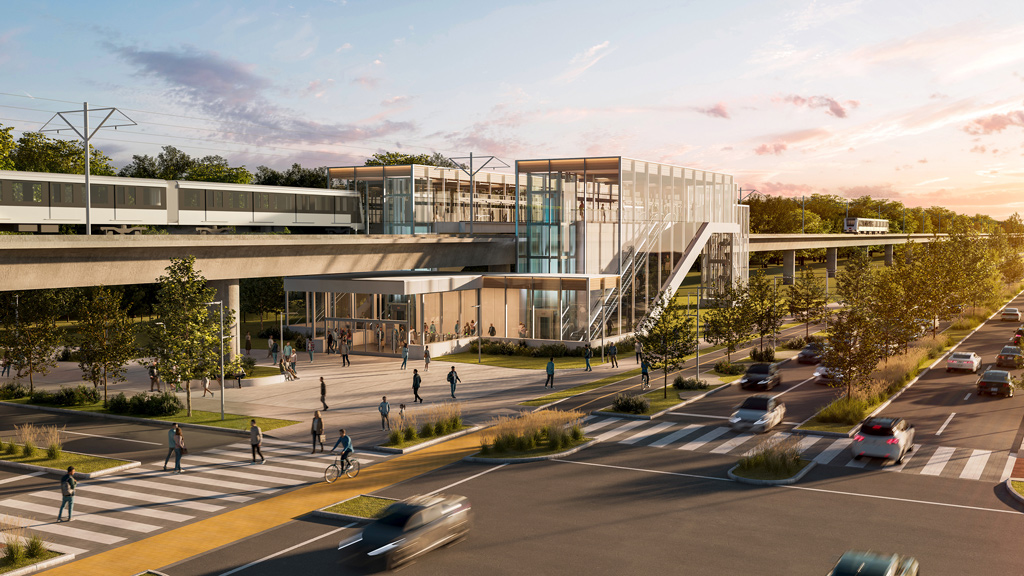Planning is underway for a $10-billion extension of the light rail transit (LRT) system in Montreal that will create 60,000 jobs during the six-year construction period and contribute $6.3 billion to Quebec’s GDP.
The Reseau express metropolitain (REM) de l’Est will add 23 new stations and 32 kilometres of mostly elevated track that will run from downtown Montreal and split into two lines to connect with several boroughs in the east and northeast.
The extension will cross 27 million square feet of vacant land along the Saint Lawrence River and join with the existing 67-kilometre REM network now under construction, making it the biggest driverless system in the Americas and one of the biggest in the world.
“We are actively committed to delivering a new sustainable mobility solution to meet the significant mobility needs in the eastern and northeastern parts of the metropolis,” says Virginie Cousineau, director public affairs for the REM de l’Est. “We are currently meeting with the authorities, civil society and the community to present the details of the project and set up channels of discussion for future exchanges.”
The pricetag for the project is the largest amount ever invested in public transit in Quebec. It is being built so people can commute by public transit to employment hubs along the route and in downtown Montreal.
“The REM de l’Est will act as a catalyst for the development of the east end of Montreal by improving user mobility,” says Cousineau. “The project will ease access to commercial arteries in eastern and northeastern Montreal, reduce travel time for commuters and serve to connect business, employment, health, education and recreation hubs.”
The LRT is expected to increase productivity as a result of time savings and reduce economic losses associated with traffic congestion. In 2018, the losses were estimated at $4.2 billion per year in Montreal.

“In making these employment hubs easily accessible by public transit, REM de l’Est will help increase the attractiveness of the area’s businesses and organizations and help retain employment in the sector,” says Cousineau.
The REM de l’Est will accommodate more than 133,000 users per day and, because it is a 100 per cent electric network, reduce greenhouse gases by 35,000 tonnes each year. Ultimately, it will eliminate 165 million vehicle-kilometres per year by 2044 and the noise pollution associated with traffic congestion.
The City of Montreal and the province, through its subsidiary Caisse de depot et placement du Quebec (CDPQ), are funding the project. They chose a mostly elevated system because of its range of benefits, one being that it minimizes the ground footprint.
An elevated route also prevents territorial fragmentation, allows for new public spaces to be created beneath structures and near the stations, and views while travelling will showcase the Saint Lawrence River.
The route will be above ground on the media strip on Rene-Levesque Boulevard, along the north side of Notre-Dame East and above the median strip on Sherbrooke Street. It will be mostly underground along Lacordaire Boulevard.
The elevated structure and stations will have a modern aesthetic that is emblematic of downtown Montreal, and in line with other major cities around the world.
“There are examples of other places in the world where similar networks have been successfully integrated into the urban area,” says Cousineau. “An advisory committee will be set up in collaboration with the City of Montreal so recommendations can be submitted prior to the design, thereby maximizing the network’s architectural integration with the environment through which it will travel.”
Architectural firms from Quebec have also been mandated to ensure the structures and stations integrate harmoniously with the existing environment.
“We believe that an elevated light rail system that criss-crosses Montreal’s east end will offer a new signature for Montreal,” says Cousineau. “Passengers will have access to interesting visual perspectives as they discover the diverse neighbourhoods along the way.”
She says the challenges of integrating a light rail system in downtown Montreal are significant and an exhaustive analysis was conducted to identify the best way to connect the downtown to the eastern tip of Montreal Island. Experts assessed the different modes of transit and possibility of going underground.
“We left no stone unturned in evaluating the technical feasibility of a tunnel route in the downtown area. The analysis was not conclusive.”
Since there is a great deal of underground infrastructure in the downtown area, building an elevated structure provides flexibility in terms of selecting station locations and adjusting the route to better accommodate the city’s physical constraints, says Cousineau.
“The light metro transit system on an overhead structure is the only one that meets transit objectives and minimizes construction risks while providing an opportunity to adopt innovative urban and architectural integration strategies.”
CDPQ president and CEO Charles Emond said in a statement that thanks to the innovative spirit and world-class expertise of teams in developing major infrastructure ventures, the project group is putting forward a proposal that meets the need for mobility in the eastern and northeastern sectors of the island.
“This is a sustainable investment that will contribute to Quebecers’ retirement plans and generate significant benefits for the economy, the environment and communities. At CDPQ, we call this constructive capital, since it allows us to combine performance and progress.”











Recent Comments